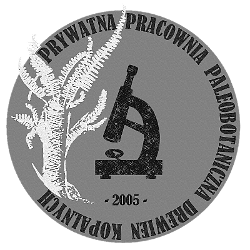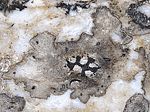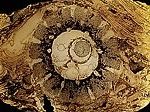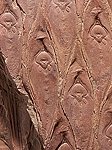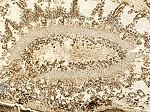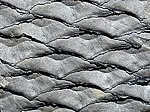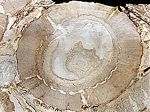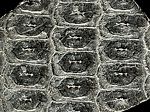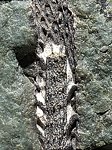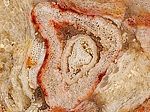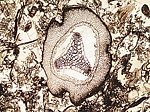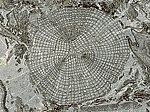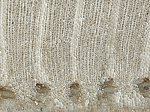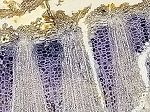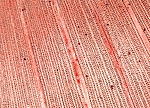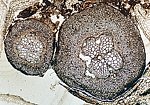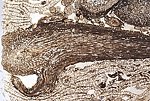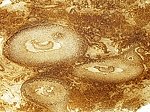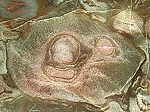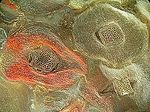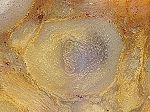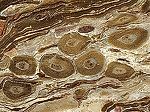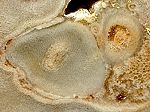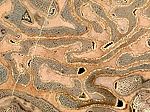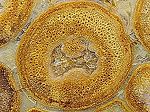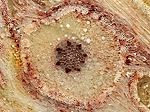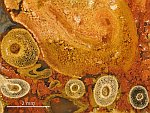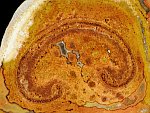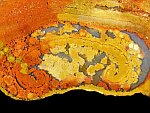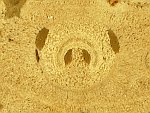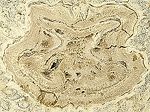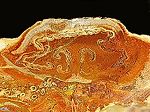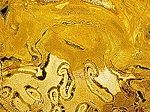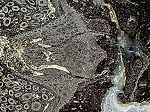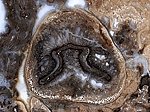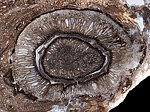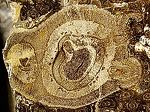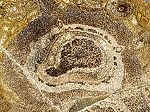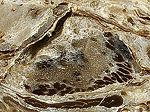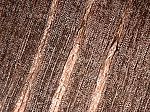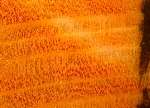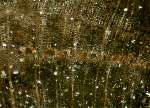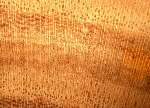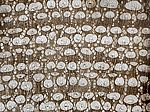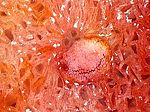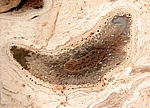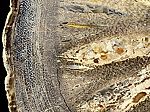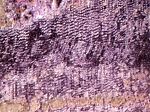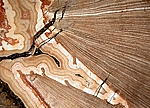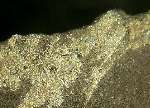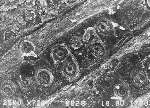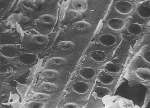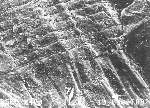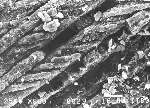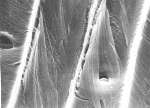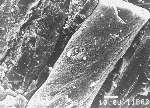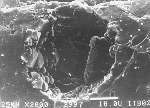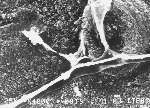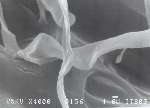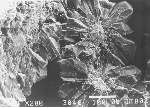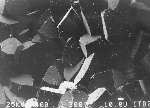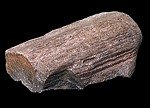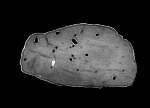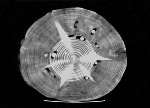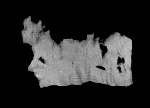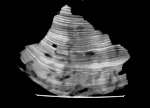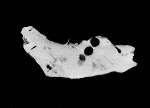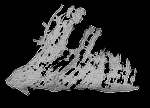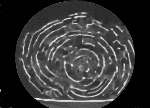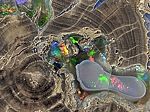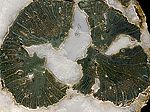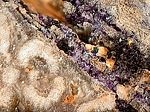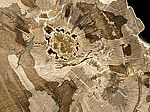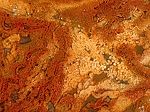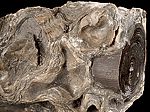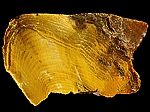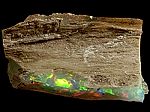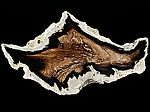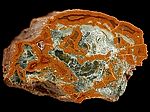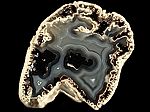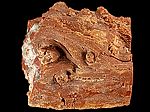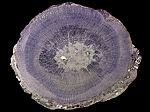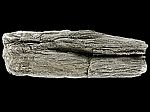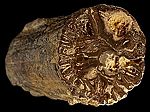The Private Palaeobotanical Laboratory of Fossil Wood operates since 2005 in Warsaw, Poland. In 2008 a terrain branch of the Laboratory was established in Twardogora.
Its activities are focused on:
– the study of fossil remains of woody plants, especially wood, including to identify taxonomic affiliation,
– gaining and gathering research materials of fossilized flora,
– searching for the fossils in a premises.
Note: the page uses JavaScript to display the photographs, to see the photos in the miniviewer allow to run the scripts.
1. Stereoscopic optical microscope
Anatomical details visible in cross sections of petrified wood (photographed by Ireneusz Niemirowski)
|
Asteroxylon mackiei, starshaped xylem, Devonian, United Kingdom |
Lepidodendron selaginoides, Carboniferous, United Kingdom |
Lepidodendron sp., leaf cushions, Carboniferous, Poland |
|
Lepidophloios sp. (Lycophytina), stem with a branch (see arrow), visible xylem around the pith, leaf traces and leaf cushions, Carboniferous, USA |
Lepidophloios sp. (Lycophytina), leaf cushions, Carboniferous, Germany |
|
|
Sigillaria sp., secondary xylem around wide pith, Carboniferous, USA |
Sigillaria sp., leaf cushions, Carboniferous, Poland |
Lycophytina, leaf traces in longitudinal view of stalk, Devonian, Ukraine |
|
Sphenophyllum sp., triangular primary xylem, secondary xylem and bark layers, Permian, Brasil |
Sphenophyllum sp., young stalk with xylem and bark layers, Carboniferous, United Kingdom |
Sphenophyllum sp., stalk with long-term secondary growth, Carboniferous, Russia |
|
Arthropitys sp., primary xylem, carinal canals, secondary xylem and rays, Carboniferous/Permian, Poland |
Arthropitys sp., primary xylem, carinal canals, secondary xylem and rays, Permian, Germany |
Arthropitys sp., secondary xylem, Permian, Brasil |
|
Stauropteris oldhamia, basalmost axis with four-lobed xylem and smaller diameter lower-order axis, Carboniferous, United Kingdom |
Stauropteris oldhamia, lower-order axis with dichotomous branch, Carboniferous, |
Metaclepsydropsis duplex, petioles (phyllophores) with xylem, Carboniferous, |
|
Symplocopteris sp., split stem with forming of the petiole, |
Symplocopteris sp., adventitious roots, |
Yulebacaulis normanii, petiole with vascular bundle, Cretaceous, Australia |
|
Botryopteris cf. forensis, petioles with vascular bundles, Carboniferous, Czech Republic |
Botryopteris nollii, stem and petiole with vascular bundles, Permian, Brasil |
Psaronius sp., anatomical structure of the vascular bundles, Carboniferous, Czech Republic |
|
Psaronius sp., adventitious root, Permian, France |
Psaroniaceae adventitious root, Permian, Brasil |
Osmundaceae, fragment of petiole with coprolites and adventitious roots, Jurassic/Cretaceous, Australia |
|
Osmundacaulis nerii, petiole, parenchyma cells in two clusters above the vascular strand "C", Jurassic/Cretaceous, Australia |
Osmundacaulis janii, petiole, chain-shaped sclerenchyma in the "C" concavity, Jurassic/Cretaceous, Australia |
Millerocaulis cf. kidstonii (Ashicaulis cf. kidstonii), petiole, two sclerenchyma clusters in the "C" concavity and in the sclerotic ring, Cretaceous, Australia |
|
Osmundaceae petiole with stipular wings, Jurassic, Australia |
„Cibotium” tasmanense, petiole, Jurassic, |
Oguracaulis banksii, petiole, Jurassic/Cretaceous, |
|
Oguracaulis banksii, forming of the petiole, Jurassic/ Cretaceous, Australia |
Conantiopteris sp., |
Dennstaedtiopsis aerenchymata, petiole with aerenchymatous tissue, Eocene, USA |
|
Dennstaedtiopsis aerenchymata, stem with aerenchymatous tissue in pith and cortex, Eocene, USA |
Tempskya sp., in the center of the stem forming of the petiole visible and on the left side - separating of the petiole, |
Tempskya sp., stem with two adventitious roots, |
|
Myeloxylon sp., petiole of Medullosa sp. seed fern, Carboniferous, Czech Republic |
Schilderia sp., broad rays in secondary xylem, Triassic, USA |
Sequoia-like petrified wood Sequoiaxylon sp., tracheids visible, USA |
|
Resin canals in petrified wood, Poland |
Ulmus-like petrified wood Ulmoxylon sp., vessels visible, USA |
Mennegoxylon jonesii, secondary xylem, Eocene, USA |
|
Palmoxylon sp., anatomical structure of the vascular bundle, Oligocene, USA |
Adventitious root of a palm - Rhizopalmoxylon sp., Indonesia |
Protoyucca shadishii, primary and secondary cylinders with bark layers, Neogene, USA |
|
Fluorite in petrified wood, Germany |
Agate in petrified wood, Madagascar |
Piryte in petrified wood, Poland |
2. Scanning electron microscope
Photographed by:
the late Prof. Dr. Zbigniew Laurow, Warsaw Agricultural University (SGGW),
Dr. Tadeusz Narojek, Warsaw Agricultural University (SGGW).
|
Submicroscope structures in petrified wood |
Submicroscope structures in living tree |
Radial longitudinal section |
|
Submicroscope structures in petrified wood |
Submicroscope structures in living Pinus |
Amber in petrified wood |
|
Resin canal |
Spawn of fungi in petrified wood |
Spawn of fungi in living tree |
|
Chalcedony in petrified wood |
Quartz in petrified wood |
3. Computed tomography scanner
Photographed by:
the late Prof. Dr. Zbigniew Laurow, Warsaw Agricultural University (SGGW),
Dr. Tadeusz Narojek, Warsaw Agricultural University (SGGW).
|
Petrified wood from Kotlina Klodzka, Poland, without visible traces of insects and tomograph of the same wood with good visible tunnels |
Living Pinus with insects feeding ground |
|
|
Feeding ground of Coleoptera (probably Cerambycidae family) in petrified wood |
Feeding ground of Arhopalus rusticus in living Pinus |
Feeding ground of Hymenoptera (probably Siricidae family) in petrified wood |
|
Feeding ground of Hymenoptera (probably Formicidae family) in petrified wood |
Feeding ground of Camponotus herculeanus in living tree |
|
4. Occurrence and age of petrified wood
Find and collectible today petrified wood comes from different geological eras and represent a variety of plant species. Is found on all continents.
Some of the locations are vast areas of forest remains – sometimes even trunks buried in the position of growth. Others, just small – in comparison to the previous – occurrences of fossils applied in secondary deposits.
Remains of several dozen meters trunks of woody plants are found, as well as fragments of few centimeters. Some of them can boast of "knowledge" of the dinosaurs, but the oldest are from Morocco (Hamar Laghdad), the Givetian (Middle Devonian) and dating back around 380–372 million years old, while some of the latest remains of petrified wood dates back to the Middle Pleistocene – are known from the province Tak in Thailand, and the location Dunarobba in Italy (these are about 40 thousand years).
5. Identifying of petrified wood
Fossils of wood can be successfully identified. Often visible to the naked eye are figures of annual growth rings, rays and wood knots. However, in order to determine the position of the generic or species, microscopic observation of anatomical structures is necessary.
Minerally fixed structures, for example, vessels, tracheids, vascular bundles, resin canals, leads to the identification of diagnostic features of wood, and thus to the species identification.
6. Minerals and singularities occurring in petrified wood
Some exhibits of petrified wood, in addition to species diversity, deserve special attention because of the minerals present in them and the peculiar characteristics. For example, look spectacular specimens with agate, or those with quartz crystals crystallized on the surface, which are also sometimes in the interior of the specimen, or even forming in the small geodes.
In silicified wood the presence of minerals not belonging to the group of silica, such as, for example, pyrite, calcite or fluorite, is less common.
The distinguishing features of the species are observed in the petrified wood singularities. For example, traces of wood invading organisms and coprolites (fossilized excrements) of organisms feeding on wood, or inhabiting wood.
Very unique are specimens showing radioactive or phosphorescence.
Examples of petrified wood with the outlined features are shown below.
7. Wood petrifying factors
The most common remains of petrified wood were formed by the silicification process, in which the petrifying substance is silica.
Silica gel (H4SiO4) fossilising plant tissues may pass in consecutive varieties:
– opal,
– chalcedony (including, for example agate),
– quarc.
Other, less common wood petryfying factors can be (P. Buurman 1972):
– apatite,
– calcium carbonates (calcite, aragonite), magnesium, iron (siderite),
– iron sulfides (pyrite, marcasite), zinc,
– iron oxides (goethite, hematite).
Examples of wood mineralized by the varieties of silica and iron oxides, fluorite and pyrite are shown below.
8. Colors of petrified wood
The variety of petrified wood colors is not due to wood color of living plants and its species, but is dependent on the presence of minerals that penetrate the silica which mineralized remains. Thanks to minerals colorless quartz gains hue. The perpetrators of the occurrence of colors in the petrified wood can be:
– chrome – green, blue,
– cobalt – green, blue,
– silica – white, gray,
– manganese – pink,
– copper – green, blue,
– manganese oxide – black, blue, purple,
– iron oxide – red, brown, orange, yellow,
– coal – black.
In the Gallery there are showed many specimens of unusual color palette.
Photographs of scanning electron microscopy and tomograms received the courtesy of the late Professor Zbigniew Laurow.
Sandra Niemirowska
